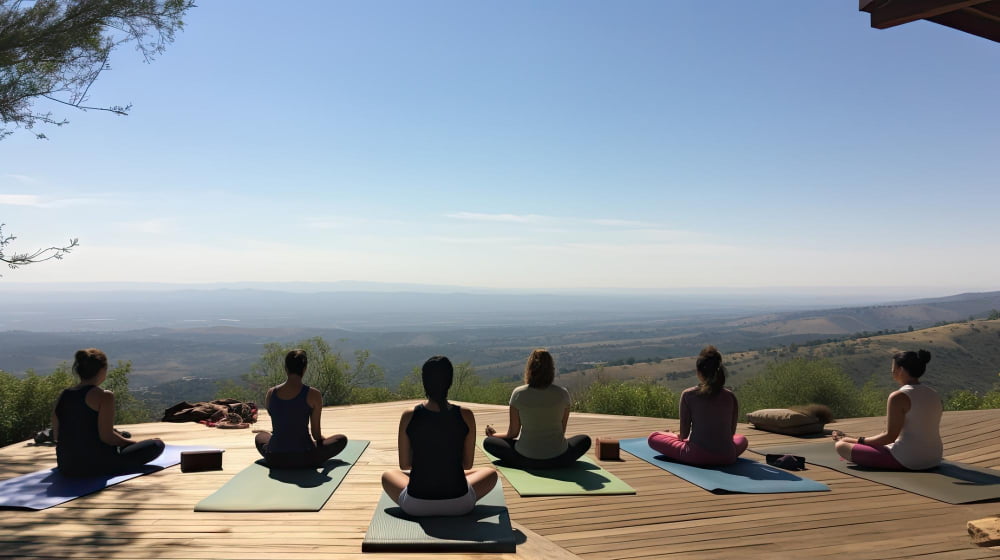Embark on the enlightening path of becoming a meditation teacher because the world thrives on the peace and calm your guidance can radiate.
Embarking on the journey to become a meditation teacher is a transformative experience that combines personal growth with the joy of helping others. This path requires dedication, training, and a deep understanding of mindfulness practices.
To become a meditation teacher, you’ll need to immerse yourself in meditation practice, undergo a certified teacher training program, and cultivate your teaching skills.
This article will guide you through each step, providing comprehensive details on the qualifications, training, and traits necessary to excel in this fulfilling profession. Rest assured, you’ll find all the information you need to navigate your journey towards becoming a meditation teacher.
Key takeaways:
- Grasp core principles of meditation: concentration, mindfulness, relaxation, loving-kindness.
- Understand diverse meditation practices: mindfulness, transcendental, Zen, Taoist, loving-kindness, Christian contemplative, Sufi, Kabbalistic.
- Sharpen teaching skills: clear communication, attuned observation, active listening, patience, continuous learning.
- Establish consistent personal meditation practice: serene space, fixed schedule, start small, experiment with styles, practice patience, maintain a journal.
- Cultivate compassion and loving-kindness: practice Metta meditation, be self-aware and kind, integrate compassion into daily life, lengthen compassion meditations.
Master the Core Principles of Meditation

Firstly, it’s essential to delve deep into the primary tenets of meditation before passing your knowledge onto others. This process involves understanding the key pillars of meditation: concentration, mindfulness, relaxation, and loving-kindness, which all work in sync to create a meditative state.
Concentration is the ability to focus on a single object or thought, tackling any distractions that may arise. Developing this skill helps keep the mind steady and poised, crucial in meditation.
Mindfulness is about being fully present in the moment, observing each breath, sensation, thought, and emotion as it arises without judgment. It cultivates self-awareness and acceptance, helping you to stay anchored in the present.
Relaxation is all about releasing physical and mental tension. Through meditation, you should be able to achieve a state of deep relaxation that fosters wellness and enhances overall well-being.
Lastly, loving-kindness, or metta, is a practice focusing on the cultivation of unconditional positive regard towards all beings. It promotes compassion and openness, fostering a sense of connectedness and empathy in your meditation practice.
Grasping these core principles allows for a deeper comprehension of meditation and a more effective way of teaching it. Remember, teaching carries the responsibility of imparting knowledge clearly and accurately so that your students can benefit fully from your instructions. Therefore, having a thorough understanding of these principles is an indispensable step in becoming a competent meditation teacher.
Understand the Diverse Global Meditation Practices and Techniques

Numerous styles of meditation can be found worldwide, each with unique techniques originating from various spiritual and cultural contexts.
1. Mindfulness Meditation: Grounded in Buddhist teachings, this involves focusing on your surroundings, thoughts, or a particular object to cultivate mindfulness and moment-to-moment awareness.
2. Transcendental Meditation: This Hindu-origin technique involves silent repetition of a specific mantra, promoting deep states of relaxation.
3. Zen Meditation (Zazen): Part of Buddhist practice, Zazen includes specific postures and focuses on breath and mindfulness.
4. Taoist Meditation: This Chinese approach invokes harmonizing with nature, with practices including Tai Chi and Qigong, centering around energy flow.
5. Loving-kindness Meditation (Metta): A Buddhist practice aiming to cultivate love and kindness towards everything, even a person’s stressors and enemies.
6. Christian Contemplative Meditation: This practice involves stilling the mind and focusing on a single word, prayer, or phrase from Christian spiritual texts.
7. Sufi Meditation (Muraqaba): An Islamic practice where the meditator cultivates awareness of spiritual realities beyond the material world.
8. Kabbalistic Meditation: These Jewish practices involve focusing on divine names or aspects of divine life.
Understanding these diverse approaches enhances your grasp on meditation’s universality and adaptability, allowing you to effectively draw from various traditions in your teaching.
Sharpen Your Skills for Teaching Meditation Effectively

To be an effective meditation teacher, developing a deep comprehension of the techniques is just as important as the ability to communicate them.
1. Clear and concise communication: Make instructions easy for students to follow. Begin each session with an explainer, addressing all levels of learners.
2. Attuned observation: Develop the capability to observe your students. Tune in to their postures, breathing patterns, and overall energy. This can guide you to offer individualized advice.
3. Practice active listening: Be available for inquisitiveness and concerns. Understand your student’s needs to guide them appropriately.
4. Demonstrate patience and empathy: Learning and mastering meditation takes time. It’s important to be patient and empathetic when students stumble or struggle.
5. Continuous learning: Always seek to expand your knowledge. This not only enhances your personal practice but also makes your teachings more profound.
Remember, as a meditation teacher, you play a significant role in nurturing the students’ journey. Your expertise, kindness, and dedication can make a monumental difference in their meditation experience.
Establish a Consistent Personal Daily Meditation Practice

To infuse depth and authenticity into your teachings, honing your personal daily meditation practice is essential. Following a regular routine not only strengthens your skills, but also reinforces the principles of mindfulness and focus.
Here are some pointers to enhance your daily meditation practice:
- 1. Create a serene space: Dedicate a calm corner of your house to meditation, free from disturbances and clutter.
- 2. Set a fixed schedule: Choose a specific time daily for meditation. Early mornings or post-sunset periods are often ideal.
- 3. Start small: Begin with short periods of 10 to 15 minutes and gradually increase the duration.
- 4. Experiment with different styles: This will allow you to understand the nuances and benefits of various meditation techniques.
- 5. Practice patience: Meditation is a journey, not a destination. Accept slow progress without frustration or judgment.
- 6. Maintain a meditation journal: Document your insight, experiences, emotions and breakthroughs. This can serve as a valuable resource in your teaching journey.
Remember, a sustainable practice is better than an overwhelming routine. Find your rhythm, stay consistent, and cherish the process of self-discovery. The journey is the reward.
Cultivate Compassion and Loving-kindness in Meditation

To foster compassion and loving-kindness within your meditation practice, a few core points need to be respected.
First, one must become familiar with Metta meditation. Metta, or loving-kindness meditation, is a Buddhist practice that promotes an attitude of empathy and love for oneself and others. Regularly practicing Metta meditation can help you in your path to becoming a compassionate and effective meditation teacher.
Second, a fundamental aspect of compassion cultivation is self-awareness and self-kindness. Some mindfulness exercises can boost this trait, such as keeping a gratitude journal, where you note down everyday things for which you are thankful, or practicing self-loving affirmations.
Third, integrate compassionate action into daily life. This could include practicing small acts of kindness, volunteering, or simply listening to someone who needs to be heard.
Lastly, remember that compassion is like a muscle. With consistent practice and dedication, it will grow stronger. Meditations focused on compassion can be gradually lengthened, ranging from a few minutes to longer periods, as they train the mind and the heart to be more open, accepting, and kind.
While teaching meditation, you, as a teacher, will be an instrument of service. Cultivating compassion and loving-kindness within your meditation practice makes you a better conduit for these teachings, impacting not just your growth but also the growth of your students.
Nurture Connections Within the Meditation Community

Establishing meaningful relationships with fellow meditation practitioners and teachers can greatly enrich your journey. These connections can provide peer support, inspiration, and opportunities for collaboration. Here are a few ways to foster those connections:
1. Join Meditation Groups: Participating in local or online meditation circles can provide a sense of belonging and foster shared learning experiences.
2. Attend Workshops or Seminars: These events can expand your knowledge base and present opportunities to interact with seasoned meditation teachers.
3. Engage in Online Forums: Virtual platforms like discussion groups or social media can connect you with a global community of practitioners.
4. Volunteer at Meditation Centers or Retreats: This service not only deepens your familiarity with meditation practices but also helps you build ties with like-minded practitioners.
5. Stay Humble and Open-minded: Ensure you’re approachable and respectful across all interactions, demonstrating the values you wish to instill in your prospective students.
These points serve as a guide, but remember that genuine relationships often grow organically. Stay patient and committed to your journey of becoming a meditation teacher.
Formulate and Implement a Strategy for a Successful Meditation Teaching Career

In planning for a successful career as a meditation teacher, several key steps come to mind:
1. Identify your niche: Define your unique teaching style that sets you apart and resonates with a specific audience. It could be mindfulness meditation, transcendental meditation, loving-kindness meditation, or another method.
2. Build a strong brand: Create a personal brand that reflects your beliefs, style, and teachings. This can be achieved through a unique logo, a catchy tagline, a professional website, and an active social media presence.
3. Foster a supportive network: Connect with fellow meditation teachers, join networks or associations, and participate in forums for continued learning and support.
4. Collaborate and partner: Reach out to wellness, yoga, health, and corporate institutions for collaborations and partnerships. This can extend your reach and bring more opportunities.
5. Continued education and training: Never stop learning. Attend advanced training courses and workshops to stay updated, enhance your skills, and deepen your knowledge.
6. Provide value to your students: Always strive to deliver quality, engaging content to your students, and remain responsive to their needs. It promotes trust and loyalty, paramount for a lasting career.
Remember, patience, dedication, and genuine passion for teaching meditation are fundamental to successfully strategizing and implementing your career plan.
FAQ
How do I qualify as a meditation teacher?
To qualify as a meditation teacher, one must successfully complete an official, established education program endorsed by a recognized authority such as The American Institute of Health Care Professionals, Inc.
How much money do meditation teachers make?
The average annual salary for meditation teachers is approximately $59,191, though this can fluctuate based on factors such as location, experience, and type of employment.
Is there a demand for meditation teachers?
The growing interest in mindfulness and meditation practices has generated a high demand for qualified meditation teachers.
Do meditation teachers make good money?
Yes, meditation teachers can make good money, with some earning up to 45.2% more than the average salary of $48,849.
What characteristics make a successful meditation teacher?
A successful meditation teacher exhibits qualities such as thorough knowledge in meditation techniques, expert communication skills, emotional intelligence, patience, and the ability to inspire and guide students on their mindfulness journey.
What are the steps involved in opening a meditation studio?
The steps involved in opening a meditation studio include creating a business plan, researching the market, finding a suitable location, obtaining necessary permits and licenses, decorating the space to create a serene atmosphere, and promoting the studio through marketing and public relations strategies.
How can one continuously improve their skills as a meditation teacher?
A meditation teacher can continuously improve their skills by actively seeking self-improvement through consistent practice, participation in training and workshops, acquiring in-depth knowledge about various meditation techniques, and embracing constructive feedback from students.